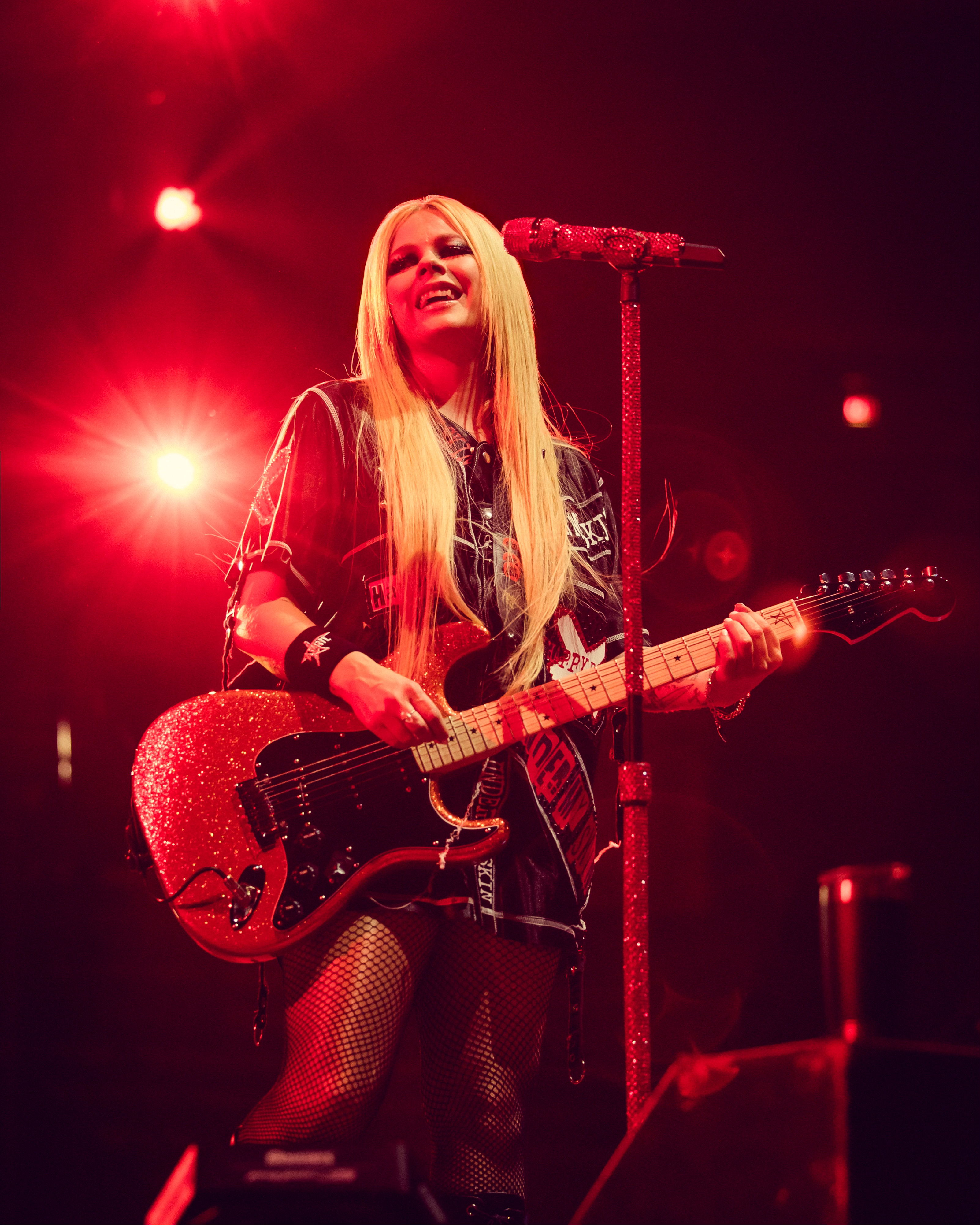Avril Lavigne Relies on Sennheiser EW-DX for Greatest Hits Tour, Building on Decades-Long Legacy of Using Sennheiser Mics and Wireless Systems
December 12, 2024

Old Lyme, CT, December 12, 2024 — It has been more than two decades since Canadian pop-punk princess Avril Lavigne burst onto the scene singing through a Sennheiser Evolution Wireless 565 microphone as she toured the world in support of her chart-topping, multi-Platinum debut album. Lavigne continues to favor Sennheiser vocal mics, and on her recent Greatest Hits Tour, her eighth global jaunt, she and her band upgraded from Sennheiser’s analog Evolution Wireless G4 systems to the latest iteration of Evolution Wireless Digital products, the EW-DX series, for their guitars.
Jesse Cole, Lavigne’s monitor engineer since her 2022 Love Sux Tour, reports that the new digital EW-DX wireless bodypacks and receivers represented an upgrade from the band’s outdated Sennheiser wireless guitar system, which supported frequency bands that are no longer available. He especially appreciates the ease with which the new EW-DX SK bodypacks pair with the receiver channels in the new RF system. “My favorite is the sync feature,” Cole says. “Guitarists no longer have to bring their pack up to the receiver, they can leave their pack wherever it is. You just hit the SYNC button. That is amazing to me.”

Guitar tech Eric Hillman, a 20-year veteran of the touring business who joined Lavigne in May 2024 at the start of the Greatest Hits Tour, was also thrilled with the new sync feature. “The first thing that blew me away was that I don't have to have my guitar right in front of the unit to sync up,” he says. “That's huge for a guy who used to have to put on 12 guitars a day, walk up to the unit and stand there. I was pretty stoked at how easy it was.”
Greatest Hits with Sennheiser EW-DX
The four-month-long Greatest Hits Tour, which wrapped up in late September, carried eight channels of EW-DX receivers, four for Lavigne and four for touring guitarist Cameron Hurley. Of the eight channels, half of them were the EW-DX EM 4 Dante. "The EW-DX 4 channel provides a cleaner digital sound than its predecessor with a low noise floor. Having a 4 channel in the rack can compare to other units in the industry at a more affordable price.“ says Cole. “She has a main and a backup guitar on their own frequencies, an acoustic, then there’s a spare channel,” Hillman adds. The fourth channel was typically used for guest musicians including Simple Plan, the band that opened for Lavigne on the final leg of the recent tour, he reports.
Hurley’s fourth channel was also used for guests, Hillman continues. “But for the most part, the receiver was for four different guitars. Paired with my line switcher it's really powerful, because we have a lot of different songs on different tunings. It just makes it easier for the soundcheck or the show to go from guitar channel A to C to D, or whatever.”

The transition to fully digital wireless was seamless and smooth, he says. “It sounds very clean. And Cam's got a pedal on stage, but even running a 50-foot cable to the stage and 50-foot back, it's still dead silent and crystal clear.”
As for features, Hillman says, “There are lots of little things, but a really cool feature is that when you turn the bodypack off screen blacks out, but you can still see what frequency it was on. That’s great.”
Making RF coordination a breeze
Cole, who was also the tour’s RF coordinator, reports that he had no problem finding workable frequencies as they made their way across North America, through Europe for a string of festival dates then back to North America. “It's been really easy, because I have a couple of different ranges out here. I'm using the AW [516 MHz to 558 MHz], GW [558 MHz to 626 MHz] and the new Q1 through Q9 [470.2 MHz to 550 MHz] bands.”
The tour production involved around 40 channels of wireless. “There are some cities where we typically have some issues with the AW band, for example, places that are well known for their RF issues,” says Cole, who uses Sennheiser’s Wireless System Manager software to monitor his channels. But the new EW-DX system offers a solution for dense RF environments, he notes. “Using Link Diversity I can pull my frequencies a little closer together and still not have any issues with intermod or anything like that.” In LD (Link Diversity) mode the system enables more frequencies to be used in the available frequency spectrum without intermodulation by reducing the modulation bandwidth of the transmitter.
Stellar sound and a career-long relationship with Sennheiser
Overall, with the new EW-DX digital setup for the guitars, Cole says, “The biggest thing for me is that the noise floor is a lot cleaner. It doesn't pick up a lot of static, noise or anything in the background. It’s a game-changer.”

Lavigne has had an almost career-long relationship with Sennheiser vocal microphones, which continues. “We have five custom mics for Avril, each a different color, and then three guest mics that we bring out each day,” Cole shares. “We use the SKM 5200 transmitter and the MD 5235 capsule on everything, with EM 3732 receivers.” When performing at festivals or other venues where sound production is provided in-house, he adds, “We always request Sennheiser EM 6000 receivers and throw her on the MD 9235 or now the MM 435.”
[ends]
Photo credit: Skyler Barberio

Daniella Kohan
Communications Manager - Americas & ANZ, Sennheiser Electronic Corporation






